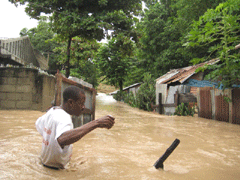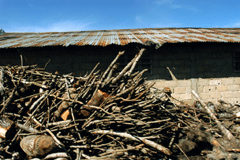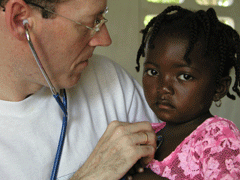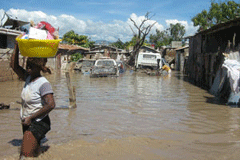Haiti’s Unnatural Disaster
Air Date: Week of September 12, 2008

(Courtesy of Partners in Health)
The slew of tropical storms that tore through the Caribbean have exacted a much higher toll on Haiti than neighboring nations. So how natural is the disaster in Haiti? Dr. Paul Farmer, vice president of Partners in Health, says deforestation and poverty are responsible for much of the suffering. Farmer talks with Living on Earth host Bruce Gellerman about his recent visit to the ravaged city of Gonaives and what it's going to take to reforest Haiti.
Transcript
GELLERMAN: From the Jennifer and Ted Stanley studios in Somerville, Massachusetts, This is Living on Earth. I’m Bruce Gellerman, in for Steve Curwood.
First Hurricane Fay hit Haiti. Then Gustav, and tropical storm Hanna, then Hurricane Ike. In less than a month, four torrential storms tore through the island nation. And Haiti, already the poorest country in the hemisphere, was destroyed beyond poverty - the storms reducing it to an unimaginable level of human suffering and misery. Paul Farmer, a medical anthropologist and physician has worked in Haiti for more than 25 years. He’s cofounder of Partners in Health. The Boston based organization runs medical clinics there. Dr. Farmer says it wasn’t the storms that caused the catastrophe in Haiti: the disaster was man made.
FARMER: I think that if it were a natural disaster and a force of nature only then anywhere such a disaster occurs it will have similar outcomes, so why is the death and destruction focused in one country? And the answer is deforestation.

In the mountains outside Port-au-Prince, Haiti, residents slowly kill one of the only remaining mature trees by taking what they call "fat wood," little cuttings of sap-laden wood used to start their charcoal cooking fires. (Courtesy of Trees for Haiti)
FARMER: You know, I gotta tell you Gonaives and all these coastal places – it smells terrible there. The smell of death all over that city. And it’s so uncomfortable, you know people’s - you know clothes, whatever they have, they’ve been wearing for days. They’re wet, you know, and if they want to be dry they have to stand in the blazing sun, and then it starts raining again. So, it was very jarring and I’ve never seen anything quite like what I saw in Haiti this past weekend. But, that’s not quite true. I saw something similar four years ago, but in the same city.
GELLERMAN: It was Hurricane Jeanne.
FARMER: It wasn’t even Hurricane Jeanne, it was Tropical Storm Jeanne. And it never made landfall on Haiti. It brushed close enough by Haiti so that rains drenched these deforested mountains and, of course, then came floods, flash floods, mud slides, etc.
GELLERMAN: Why is the country so deforested?
FARMER: After the Europeans arrived in 1492, it took a long time, but first the Spanish and then the French started clearing vast tracts of land in this quite mountainous country for what’s essentially tropical produce: sugar, coffee, cotton. And Haiti became the first independent country in the hemisphere, but it still was dependent on these same agricultural products – and has been ever since.
GELLERMAN: There have been many attempts to reforest. Millions of trees have been planted there in fact. But they still have this problem – they’re cutting down more trees than they can plant. Why are they cutting down so many trees?

Harvested and dried saplings piled outside a bakery fueled by wood in the mountains near Port-au-Prince, Haiti. Wood and charcoal account for 70 percent of the energy in Haiti. (Courtesy of Trees for Haiti)
GELLERMAN: But, you have the deforestation going on, so the water from these terrible storms rushes down these mountaintops and floods the areas, but carrying with it the topsoils, so now you can’t plant crops.
FARMER: Right.
GELLERMAN: So you can’t plant food.
FARMER: That’s right.
GELLERMAN: So you’ve got this compounded, complex problem. Where do you – how do you break this vicious cycle?

Dr. Paul Farmer treating a patient in Haiti. (Courtesy of Partners in Health)
GELLERMAN: What do we do right now? I mean now they’re running out of trees, they’re running out of fuel, they’re under water, a good part of the country. The third or fourth largest city in the country is largely cut off from the rest of the world.

On the main street of Gonaïve. (Courtesy of Partners in Health)
When we went into Gonaives on Saturday, supposedly it was cut off from the rest of the world, right? You fly into Haiti and you see the city’s under water. There is a mass exodus of the city on foot, we saw no first aid stations outside of the city. And when we asked them, “Well, where are you going?” they’d name other towns or Port-au-Prince and they’d say, “Do you have any water?” So, in the short term, we have to attend to people’s thirst. But in the long term, that area has to be reforested, but again, you can’t reforest without an alternative fuel plan, without job creation, and without addressing this whole, really, bundle of problems.

A Partners In Health worker wades through floodwaters to find missing HIV patients. (Courtesy of Partners in Health)
And this is not like putting a man on the moon or sending some spaceship to Mars. This is well within the realm of human possibility.
GELLERMAN: Well Dr. Farmer, I want to thank you very much.
FARMER: Well thank you, Bruce.
GELLERMAN: Dr. Paul Farmer, co-founder of Partners in Health. Soon after our conversation Dr. Farmer returned to Haiti.
Links
Living on Earth wants to hear from you!
Living on Earth
62 Calef Highway, Suite 212
Lee, NH 03861
Telephone: 617-287-4121
E-mail: comments@loe.org
Newsletter [Click here]
Donate to Living on Earth!
Living on Earth is an independent media program and relies entirely on contributions from listeners and institutions supporting public service. Please donate now to preserve an independent environmental voice.
NewsletterLiving on Earth offers a weekly delivery of the show's rundown to your mailbox. Sign up for our newsletter today!
 Sailors For The Sea: Be the change you want to sea.
Sailors For The Sea: Be the change you want to sea.
 The Grantham Foundation for the Protection of the Environment: Committed to protecting and improving the health of the global environment.
The Grantham Foundation for the Protection of the Environment: Committed to protecting and improving the health of the global environment.
 Contribute to Living on Earth and receive, as our gift to you, an archival print of one of Mark Seth Lender's extraordinary wildlife photographs. Follow the link to see Mark's current collection of photographs.
Contribute to Living on Earth and receive, as our gift to you, an archival print of one of Mark Seth Lender's extraordinary wildlife photographs. Follow the link to see Mark's current collection of photographs.
 Buy a signed copy of Mark Seth Lender's book Smeagull the Seagull & support Living on Earth
Buy a signed copy of Mark Seth Lender's book Smeagull the Seagull & support Living on Earth

